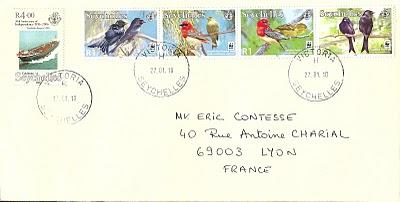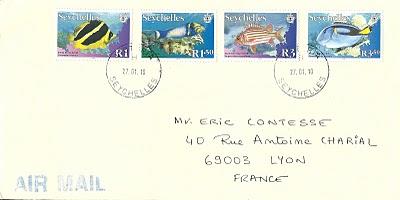Waaahooo !!! Mes 2 premières lettres reçues du paradis sur terre, des Seychelles plus précisément, un archipel de 115 îles au large de l'Afrique de l'est dans l'océan indien, dont la principale ressource est le tourisme.
En observant les splendides séries de timbres ci-dessous, on comprend mieux pourquoi !
Merci beaucoup Jean-Pierre pour ces 2 superbes surprises postées le 27 janvier 2010 de Victoria, la capitale située sur l'île de Mahé :-)
La politique d'émission de timbres de la poste des Seychelles fait rêver : des sujets locaux pour la plupart (faune et flore en particulier), anniversaires, évènements internationaux et seulement une à deux séries par an !
Waaahooo!!! My first two covers received from the paradise on earth, from the Seychelles more precisely, an archipelago of 115 islands off East Africa in the Indian Ocean, whose main resource is tourism.
By looking the splendid sets of stamps below, we better understand why !
Thank you very much Jean-Pierre for these two wonderful surprises posted on January 27, 2010 in Victoria, the capital located on the island of Mahé :-)
The policy of stamp issuing by the Post Office of the Seychelles is a dream : local issues for most (fauna and flora in particular), birthdays, international events and only one or two sets issued each year !

Ce timbre montre le tanker "Seychelles Progress" (2005), un des 3 pétroliers battant pavillons des Seychelles avec le "Seychelles Pride" et le "Seychelles Pioneer". Les Seychelles importent du golfe trois fois plus de pétrole que nécessaire et réexportent le surplus grâce à ces navires...
Les 4 autres timbres se-tenant ci-dessus font partie d'une série émise le 1er octobre 2008 composée aussi d'un bloc-feuillet de forte valeur faciale (20R). Cette série est consacrée à deux espèces d'oiseaux endémiques (le drongo d'Aldabra) et semi-endémiques (le foudi à tête rouge) des Seychelles. Chaque timbre de cette série comporte le logo du WWF.
The stamp at four Seychelles rupees (R) above on the left is part of a series of seven stamps issued on June 28, 2006 to celebrate the 30th anniversary of country's independence after being a colony of the British Empire. The Seychelles now have the particularity to be part of both the Commonwealth of Nations and the Organization of la Francophonie.
This stamp is featuring the tankship "Seychelles Progress" (2005), one of the three Seychelles' tankers with the "Seychelles Pride" and the "Seychelles Pioneer". Seychelles imports three times more oil than needed from Gulf's countries and re-export the surplus through these vessels... The four other se-tenant stamps above are part of a series issued on October 1, 2008 consisting also of a souvenir sheet of high nominal value (R 20.00). This series is devoted to two species of endemic (the Aldabra drongo) and semi-endemic (Red-headed Fody) birds of Seychelles. The now famous WWF emblem is included on each stamp of this series.

Le chirurgien bleu (Paracanthurus hepatus), le poisson-écureuil des Seychelles (Sargocentron seychellense), le Thalassoma hebraicum et le poisson-papillon indien (Chaetodon mitratus) sont représentés ci-dessus de droite à gauche.
A noter que les armoiries du pays figurent systématiquement sur les timbres des Seychelles. Elles représentent 2 espadons entourant un écusson (avec une tortue, un cocotier et un voilier) et un oiseau marin dans la partie supérieure. La devise du pays, "Finis coronat opus" ("La fin couronne l'œuvre") figure enfin dans la partie inférieure.
The four stamps above are part of two definitive series, each consisting of seven stamps, issued on November 3, 2003 (R 1, R 1.50 and R 3 stamps) and on October 3, 2005 (R 3.50 stamp), devoted to Seychelles reef fish.
The Palette Surgeonfish (Paracanthurus hepatus), the Seychelles Squirrelfish (Sargocentron seychellense), the Goldbar Wrasse (Thalassoma hebraicum) and the Indian Butterflyfish (Chaetodon mitratus) are depicted above from right to left.
It's worth noting that the arms of the country are always included on stamps of Seychelles. They feature two swordfish surrounding a shield (with a turtle, a coconut tree and a sailboat) and a seabird in the upper part. The motto of the country, "Finis Coronat Opus" ("The end crowns the work") is stated beneath the shield.


